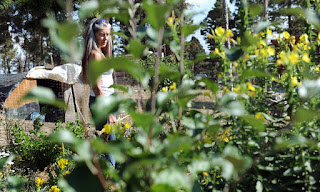 |
| Gloria Flora walks through her forest garden. |
Agroforestry, the science of incorporating trees into traditional agriculture, is not the same as converting farmland to forest. Agroforestry represents a collaborative attempt on the part of the farmer to harness the ecological services that trees provide and incorporate them into a farm. The Times writes, "Depending on the species, trees make all sorts of contributions to agriculture, experts say. Trees in a shelter belt reduce wind and water erosion. Some trees serve as fertilizers - they take in nitrogen from the atmosphere, or pump it from deep underground and, when they drop their leaves, make it available upon decomposition. Trees planted along streams can take up and scrub out polluted farm runoff. They increase species diversity by providing habitat, and some of those species are friendly to farmers - bees and butterflies that help pollinate crops, for example. (One study showed that 66 species of birds benefit from windbreaks on farms.) Trees can keep a field cooler and more moist."
Not to mention that trees in general help to offset the negative impacts of conventional agriculture by absorbing greenhouse gases and cleaning up polluted water.
This forward-thinking approach to agriculture, however, faces a difficult opposition. Conventional thinking about trees - that farmers should first remove all surrounding trees before planting and then prevent them from growing as the farm operates - has been ingrained in our collective minds for generations. The truth - that trees can be used to benefit agriculture if planted with thought and planning - may be a tough one to swallow initially, but it looks like it's starting to catch on.
Read the full article here.
Want to learn more about trees in the landscape? Register for our 2011 Organic Land Care Annual Gathering on December 6th at UConn, Storrs, CT. This year's focus is Trees: Landscaping for Future Generations, and will feature Keynote Tom Wessels, as well as a host of other exciting speakers. Click on the link above to learn more!
Have a great Tuesday!
-Melissa

No comments:
Post a Comment